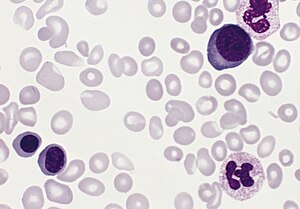Erythremia
| Polycythaemia vera | |
|---|---|
| Synonyms | Polycythaemia vera (PV, PCV), erythremia, primary polycythemia, Vaquez disease, Osler-Vaquez disease, polycythemia rubra vera |
 |
|
| Blood smear from a patient with polycythemia vera | |
| Specialty | Oncology |
| Classification |
· ·
|
|---|---|
| External resources |
Polycythemia vera is an uncommon neoplasm in which the bone marrow makes too many red blood cells. It may also result in the overproduction of white blood cells and platelets.
Most of the health concerns associated with polycythemia vera are caused by the blood being thicker as a result of the increased red blood cells. It is more common in the elderly and may be symptomatic or asymptomatic. Common signs and symptoms include itching (pruritus), and severe burning pain in the hands or feet that is usually accompanied by a reddish or bluish coloration of the skin. Patients with polycythemia vera are more likely to have gouty arthritis. Treatment consists primarily of phlebotomy.
People with polycythemia vera can be asymptomatic. A classic symptom of polycythemia vera is pruritus or itching, particularly after exposure to warm water (such as when taking a bath), which may be due to abnormal histamine release or prostaglandin production. Such itching is present in approximately 40% of patients with polycythemia vera.Gouty arthritis may be present in up to 20% of patients.Peptic ulcer disease is also common in patients with polycythemia vera; most likely due to increased histamine from mast cells, but may be related to an increased susceptibility to infection with the ulcer-causing bacterium H. pylori. Another possible mechanism for the development for peptic ulcer is increased histamine release and gastric hyperacidity related with polycythemia vera.
A classic symptom of polycythemia vera (and the related myeloproliferative disease essential thrombocythemia) is erythromelalgia. This is a burning pain in the hands or feet, usually accompanied by a reddish or bluish coloration of the skin. Erythromelalgia is caused by an increased platelet count or increased platelet "stickiness" (aggregation), resulting in the formation of tiny blood clots in the vessels of the extremity; it responds rapidly to treatment with aspirin.
...
Wikipedia
